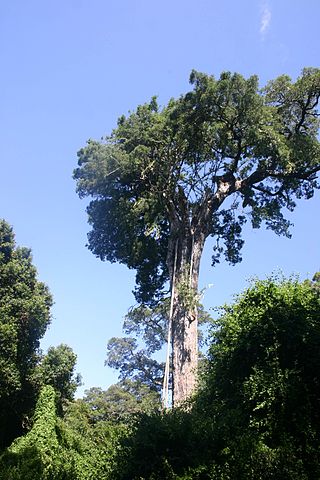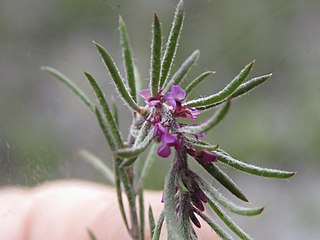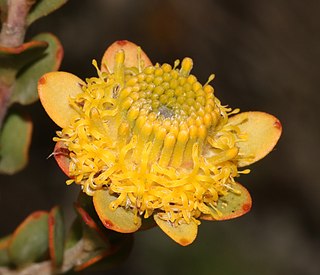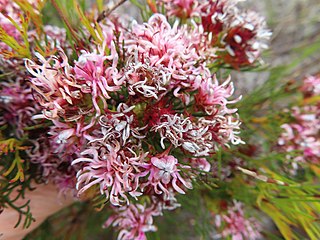Buxus nyasica is a species of plant in the family Buxaceae. It is endemic to Malawi. It is threatened by habitat loss.

Aloiampelos commixta is a flowering plant in the Asphodelaceae family. It is commonly called Table Mountain aloe, and is a rare succulent plant that is endemic to the Cape Peninsula, South Africa. It naturally occurs only on the Table Mountain range, within the city of Cape Town.

Southern Afrotemperate Forest is a kind of tall, shady, multilayered indigenous South African forest. This is the main forest-type in the south-western part of South Africa, naturally extending from the Cape Peninsula in the west, as far as Port Elizabeth in the east. In this range, it usually occurs in small forest pockets, surrounded by fynbos vegetation.

Ficus burtt-davyi is a fig species endemic to Southern Africa, belonging to the Mulberry family of Moraceae. It grows in coastal and inland forests up to 1,500 m (4,920 ft), from the vicinity of Mossel Bay in the Southern Cape to southern Mozambique - the forms growing on coastal dunes in the northern part of its range are salt tolerant and form low thickets on the margins of woodland. In the southern and eastern Cape forests the species becomes a strangler or liana, while when found on rocky outcrops and cliffs it usually develops into a rock-splitter.

Muraltia is a genus of plants in the milkwort family (Polygalaceae) which is native to Southern and Eastern Africa. Most of the species are endemic to South Africa, and one species is naturalized in Australia. It is named after Johannes von Muralt, a Swiss botanist and surgeon.

Mimetes stokoei, the mace pagoda, is an evergreen, upright, hardly branching, large shrub of 1–2 m high in the family Proteaceae. It has silvery, oval leaves of 5–8 cm (2.0–3.2 in) long and 2+1⁄2–4 cm (1.0–1.6 in) wide, with one large tooth supported by two smaller teeth near the tip, at an upward angle and somewhat overlapping each other. The inflorescences are set just below the growing tip, are cylinder-shaped, 10–12 cm (4–5 in) high, topped by a crest of small, more or less horizontal, pinkish-purple tinged leaves. It consists of several flower heads in the axils of golden leaves with a pinkish wash that form a hood shielding the underlying flower head. Each flower head contains eight to twelve individual flowers, with amber-colored styles topped by blackish purple pollen presenters and grey silky perianth lobes. It is endemic to the Fynbos ecoregion of South Africa, being confined to the Kogelberg mountain range. The mace pagoda was twice presumed extinct, but reappeared in its natural habitat from seed, after a wildfire several decades later.

The Marine biodiversity of South Africa is the variety of living organisms that live in the seas off the coast of South Africa. It includes genetic, species and ecosystems biodiversity in a range of habitats spread over a range of ecologically varied regions, influenced by the geomorphology of the seabed and circulation of major and local water masses, which distribute both living organisms and nutrients in complex and time-variable patterns.
Muraltia minuta is a flowering plant in the milkwort family (Polygalaceae). It is endemic to rocky flats to about 100 metres (330 ft) above sea level in the south-western Cape Province, South Africa.

Muraltia bolusii is a plant species in the milkwort family (Polygalaceae). It is endemic to sandy coastal flatland with altitudes below 500 metres (1,600 ft) in Western Cape, South Africa. It was first described in 1954 by Margaret Levyns in the Journal of South African Botany. The Red List of South African Plants has listed it as endangered since 2007 due to habitat loss caused by nearby urban expansion, crop cultivation, and sand mining, as well as invasive species. Its population is decreasing.

Leucadendron coriaceum, the rosette conebush, is a flower-bearing shrub that belongs to the family Proteaceae. It is part of the fynbos vegetation type of South Africa. The plant is native to the Western Cape, South Africa.

Leucadendron sorocephalodes, the woolly conebush, is a flower-bearing shrub belonging to the family Proteaceae. It is part of the South African fynbos vegetation type. The plant is native to the Western Cape and Eastern Cape where it occurs from the Outeniqua Mountains to the Baviaanskloof Mountains.

Serruria bolusii, the Agulhas spiderhead, is a flower-bearing shrub that belongs to the family Proteaceae. It is part of the South African fynbos vegetation type. The plant is native to the Western Cape and is found in Elim hills and Soetanysberg. The shrub grows upright to 1.0 m tall and flowers from August to December.
Paranomus reflexus, the Van Staden's scepter, is a flower-bearing shrub that belongs to the family Proteaceae. It is part of the South African fynbos vegetation type. The plant is native to the Eastern Cape where it occurs on the Elandsberg and Van Stadensberg.

Paranomus tomentosus, the hairy-leaf tree sceptre, is a flower-bearing shrub that belongs to the genus Proteaceae. It is part of the South African fynbos vegetation type. The plant is native to the Western Cape, South Africa.

Leucadendron nervosum, the silky-ruff conebush, is a flower-bearing shrub that belongs to the family Proteaceae. It is part of the South Africa fynbos vegetation type. The plant is native to the Western Cape, where it occurs on the Jonaskop in the Riviersonderend Mountains and Grootberg in the Langeberg. The shrub grows 1.5 m tall and flowers in September.
Leucadendron meyerianum, the Van Rhynsdorp conebush, is a flower-bearing shrub that belongs to the family Proteaceae. It is part of the fynbos vegetation type of South Africa. The plant is native to the Western Cape and Northern Cape, where it occurs in the Bokkeveld escarpment near Nieuwoudtville. The shrub grows 2.0 m tall and bears flowers in August. Two months after the plant has flowered, the fruit appears and the seeds later fall to the ground where they are spread by rodents. The plant grows in level, sandstone sand at altitudes of 800 m. Small beetles do the pollination.
Serruria dodii, the Hex River spiderhead, is a flowering shrub that belongs to the family Proteaceae. It is part of the South African fynbos vegetation type. The plant is endemic to the Western Cape and occurs in the Hex River Mountains and Keeromsberg. The shrub grows upright, reaches a height of 1.0 m and flowers from August to November.
Leucadendron radiatum, also called the Langeberg conebush, is a flowering shrub that belongs to the family Proteaceae. It is part of the South African Fynbos vegetation type. The plant is endemic to the Western Cape where it occurs on the Langeberg from Grootberg to Kampscheberg.
Serruria leipoldtii, the Leipoldt's spiderhead, is a flowering shrub that belongs to the family Proteaceae. It is part of the South African fynbos vegetation type. The plant is endemic to the Western Cape and occurs in the northern Sederberg. The shrub grows up to 1.5 m tall with a diameter of 30 cm and flowers from summer to autumn.
Sorocephalus crassifolius, the flowerless clusterhead, is a flowering shrub that belongs to the family Proteaceae.. It is part of the South African fynbos vegetation type. The plant is endemic to the Western Cape where it occurs on the Riviersonderendberge. The plants were last seen in flower in the 1980s. There are only fifteen plants left.











